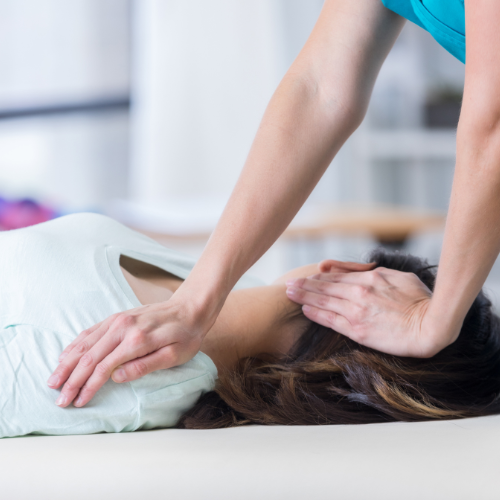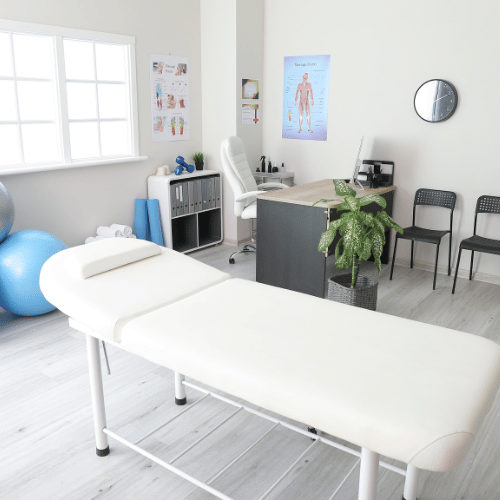Chiropractic Care You Can Trust
Serving Fairbanks and Surrounding Areas
What is Chiropractic?
Chiropractic is a health care profession that focuses on disorders of the musculoskeletal system and the nervous system, and the effects of these disorders on general health. Chiropractic care is used most often to treat neuromusculoskeletal complaints, including but not limited to back pain, neck pain, pain in the joints of the arms or legs, and headaches.
Doctors of Chiropractic practice a drug-free, hands-on approach to health care that includes patient examination, diagnosis and treatment. Chiropractors have broad diagnostic skills and are also trained to recommend therapeutic and rehabilitative exercises, as well as to provide nutritional, dietary and lifestyle counseling.
The most common therapeutic procedure performed by doctors of chiropractic is known as spinal manipulation, also called chiropractic adjustment. The purpose of manipulation is to restore joint mobility by manually applying a controlled force into joints that have become hypomobile or restricted in their movement as a result of a tissue injury. Tissue injury can be caused by a single traumatic event, such as improper lifting of a heavy object, or through repetitive stresses, such as sitting in an awkward position with poor spinal posture for an extended period of time. In either case, injured tissues undergo physical and chemical changes that can cause inflammation, pain, and diminished function for the sufferer. Manipulation, or adjustment of the affected joint and tissues, restores mobility, thereby alleviating pain and muscle tightness, and allowing tissues to heal.



 Hailey Gundersen2024-11-15I have been seeing Dr. Berg since the middle of my second trimester and it has helped subside all lower back pain throughout my pregnancy. I’m now at 35 weeks and feeling great! Could not recommend his care more.
Hailey Gundersen2024-11-15I have been seeing Dr. Berg since the middle of my second trimester and it has helped subside all lower back pain throughout my pregnancy. I’m now at 35 weeks and feeling great! Could not recommend his care more. Angela Holland2024-07-12Great chiropractors. Amazing massage therapists.
Angela Holland2024-07-12Great chiropractors. Amazing massage therapists. Caitlin Schnaidt2024-06-07I can't speak highly enough about Dr. Berg and the entire teqm at Spaulding. I am pregnant and have been suffering from bad sciatica which made doing most basic things throughout the day extremely challenging. After starting to see Dr. Berg I am finally able to get through the day without being in a constant state of pain. He also sees my special needs toddler and we have seen great improvements in his physical movements and comfort level since beginning to see Dr. Berg. He is knowledgeable, professional, friendly, warm, and overall an amazing chiropractor. Everyone in the office is friendly, warm, and welcoming. I was very hesitant about starting to see a chiropractor while pregnant and have been nothing but pleasantly surprised and satisfied with the results of both my own, and my son's, experiences. If you're looking for a chiropractors office I highly recommend Dr. Berg and Spaulding chiropractic.
Caitlin Schnaidt2024-06-07I can't speak highly enough about Dr. Berg and the entire teqm at Spaulding. I am pregnant and have been suffering from bad sciatica which made doing most basic things throughout the day extremely challenging. After starting to see Dr. Berg I am finally able to get through the day without being in a constant state of pain. He also sees my special needs toddler and we have seen great improvements in his physical movements and comfort level since beginning to see Dr. Berg. He is knowledgeable, professional, friendly, warm, and overall an amazing chiropractor. Everyone in the office is friendly, warm, and welcoming. I was very hesitant about starting to see a chiropractor while pregnant and have been nothing but pleasantly surprised and satisfied with the results of both my own, and my son's, experiences. If you're looking for a chiropractors office I highly recommend Dr. Berg and Spaulding chiropractic. Payton Baker2024-05-30Dr. Berg is hands down the best! Helped me through ALL my pregnancy pains and worked me in his schedule when I needed an adjustment ASAP! 100% recommend for anyone!
Payton Baker2024-05-30Dr. Berg is hands down the best! Helped me through ALL my pregnancy pains and worked me in his schedule when I needed an adjustment ASAP! 100% recommend for anyone! Josh Handeland2024-05-28Love theses people they are the best in town
Josh Handeland2024-05-28Love theses people they are the best in town Maggie Matheson2024-05-24Everyone is so sweet and helpful. I’ve had emergent pain and they got me right in and they are so helpful.
Maggie Matheson2024-05-24Everyone is so sweet and helpful. I’ve had emergent pain and they got me right in and they are so helpful. Tracey Ferguson2024-05-24Great staff
Tracey Ferguson2024-05-24Great staff Meghan Hoffman2024-05-20I've been seeing Dr. Wyatt Berg throughout my entire eight months of pregnancy so far, and I can't recommend him enough! He is incredibly understanding and knowledgeable about the specific needs of pregnant women. He always takes the time to listen to my concerns and adjusts my treatments accordingly. His adjustments have helped to alleviate my lower back pain and improve my sleep. Most recently, my baby went from being in the breech position to head down after a couple of adjustments. Thanks to Dr. Berg's care, I’ve felt much more comfortable and mobile throughout my pregnancy. I highly recommend him to any pregnant women or any individual who is looking for a natural and effective way to manage aches and pains. Alisha Greenberg (Massage Therapist) and Teresa Grotkopp (Acupuncturist) I would also highly recommend. The cherry on top is that the office staff at Spaulding Chiropractic is always friendly and helpful.
Meghan Hoffman2024-05-20I've been seeing Dr. Wyatt Berg throughout my entire eight months of pregnancy so far, and I can't recommend him enough! He is incredibly understanding and knowledgeable about the specific needs of pregnant women. He always takes the time to listen to my concerns and adjusts my treatments accordingly. His adjustments have helped to alleviate my lower back pain and improve my sleep. Most recently, my baby went from being in the breech position to head down after a couple of adjustments. Thanks to Dr. Berg's care, I’ve felt much more comfortable and mobile throughout my pregnancy. I highly recommend him to any pregnant women or any individual who is looking for a natural and effective way to manage aches and pains. Alisha Greenberg (Massage Therapist) and Teresa Grotkopp (Acupuncturist) I would also highly recommend. The cherry on top is that the office staff at Spaulding Chiropractic is always friendly and helpful. Nigel Morton2024-05-20Dr. Berg truly cares about his craft and his patients. His care shows in the form results from appointment to appointment.
Nigel Morton2024-05-20Dr. Berg truly cares about his craft and his patients. His care shows in the form results from appointment to appointment. Cody Whiteley2024-05-09I took my 6 week old baby to see DR. Berg for hard to pass gas, excessive fussiness and instantly he was able to ease my baby. Over just a couple visits we noticed a huge difference and baby was much happier. We took him back again at 4 months because he was constipated - google told us it was normal to have inconsistent bowel movements around his age but it made him extremely fussy and uncomfortable. Within a couple hours after seeing DR Berg our baby began making regular bowel movements again and his mood improved drastically. My wife also saw Dr Berg after giving birth and having multiple complaints of pain and unusual sensations. He helped realign her pelvis, hips and relieve upper back/neck pain associated with breastfeeding/ holding baby. Dr Berg is incredibly knowledgeable, holistic and personable. He has a baby of his own so he is very gentle and intuitive. We cant recommend his expertise enough, he truly takes the time to listen, notice, and fix the problem or recommend resources or other specialists. To say the least, Chiropractic care with Dr Berg has been a game changer for both baby and momma. Fairbanks is truly lucky to have this high quality care.
Cody Whiteley2024-05-09I took my 6 week old baby to see DR. Berg for hard to pass gas, excessive fussiness and instantly he was able to ease my baby. Over just a couple visits we noticed a huge difference and baby was much happier. We took him back again at 4 months because he was constipated - google told us it was normal to have inconsistent bowel movements around his age but it made him extremely fussy and uncomfortable. Within a couple hours after seeing DR Berg our baby began making regular bowel movements again and his mood improved drastically. My wife also saw Dr Berg after giving birth and having multiple complaints of pain and unusual sensations. He helped realign her pelvis, hips and relieve upper back/neck pain associated with breastfeeding/ holding baby. Dr Berg is incredibly knowledgeable, holistic and personable. He has a baby of his own so he is very gentle and intuitive. We cant recommend his expertise enough, he truly takes the time to listen, notice, and fix the problem or recommend resources or other specialists. To say the least, Chiropractic care with Dr Berg has been a game changer for both baby and momma. Fairbanks is truly lucky to have this high quality care.
Doctor of Chiropractic Care
Chiropractic adjustment rarely causes discomfort. However, patients may sometimes experience mild soreness or aching following treatment (as with some forms of exercise) that usually resolves within 12 to 48 hours.
In many cases, such as lower back pain, chiropractic care may be the primary method of treatment. When other medical conditions exist, chiropractic care may complement or support medical treatment by relieving the musculoskeletal aspects associated with the condition.
Doctor of Chiropractic may assess patients through clinical examination, laboratory testing, diagnostic imaging and other diagnostic interventions to determine when chiropractic treatment is appropriate or when it is not appropriate. Chiropractors will readily refer patients to the appropriate health care provider when chiropractic care is not suitable for the patients condition, or the condition warrants co-management in conjunction with other members of the health care team.
 Hailey Gundersen2024-11-15I have been seeing Dr. Berg since the middle of my second trimester and it has helped subside all lower back pain throughout my pregnancy. I’m now at 35 weeks and feeling great! Could not recommend his care more.
Hailey Gundersen2024-11-15I have been seeing Dr. Berg since the middle of my second trimester and it has helped subside all lower back pain throughout my pregnancy. I’m now at 35 weeks and feeling great! Could not recommend his care more. Angela Holland2024-07-12Great chiropractors. Amazing massage therapists.
Angela Holland2024-07-12Great chiropractors. Amazing massage therapists. Caitlin Schnaidt2024-06-07I can't speak highly enough about Dr. Berg and the entire teqm at Spaulding. I am pregnant and have been suffering from bad sciatica which made doing most basic things throughout the day extremely challenging. After starting to see Dr. Berg I am finally able to get through the day without being in a constant state of pain. He also sees my special needs toddler and we have seen great improvements in his physical movements and comfort level since beginning to see Dr. Berg. He is knowledgeable, professional, friendly, warm, and overall an amazing chiropractor. Everyone in the office is friendly, warm, and welcoming. I was very hesitant about starting to see a chiropractor while pregnant and have been nothing but pleasantly surprised and satisfied with the results of both my own, and my son's, experiences. If you're looking for a chiropractors office I highly recommend Dr. Berg and Spaulding chiropractic.
Caitlin Schnaidt2024-06-07I can't speak highly enough about Dr. Berg and the entire teqm at Spaulding. I am pregnant and have been suffering from bad sciatica which made doing most basic things throughout the day extremely challenging. After starting to see Dr. Berg I am finally able to get through the day without being in a constant state of pain. He also sees my special needs toddler and we have seen great improvements in his physical movements and comfort level since beginning to see Dr. Berg. He is knowledgeable, professional, friendly, warm, and overall an amazing chiropractor. Everyone in the office is friendly, warm, and welcoming. I was very hesitant about starting to see a chiropractor while pregnant and have been nothing but pleasantly surprised and satisfied with the results of both my own, and my son's, experiences. If you're looking for a chiropractors office I highly recommend Dr. Berg and Spaulding chiropractic. Payton Baker2024-05-30Dr. Berg is hands down the best! Helped me through ALL my pregnancy pains and worked me in his schedule when I needed an adjustment ASAP! 100% recommend for anyone!
Payton Baker2024-05-30Dr. Berg is hands down the best! Helped me through ALL my pregnancy pains and worked me in his schedule when I needed an adjustment ASAP! 100% recommend for anyone! Josh Handeland2024-05-28Love theses people they are the best in town
Josh Handeland2024-05-28Love theses people they are the best in town Maggie Matheson2024-05-24Everyone is so sweet and helpful. I’ve had emergent pain and they got me right in and they are so helpful.
Maggie Matheson2024-05-24Everyone is so sweet and helpful. I’ve had emergent pain and they got me right in and they are so helpful. Tracey Ferguson2024-05-24Great staff
Tracey Ferguson2024-05-24Great staff Meghan Hoffman2024-05-20I've been seeing Dr. Wyatt Berg throughout my entire eight months of pregnancy so far, and I can't recommend him enough! He is incredibly understanding and knowledgeable about the specific needs of pregnant women. He always takes the time to listen to my concerns and adjusts my treatments accordingly. His adjustments have helped to alleviate my lower back pain and improve my sleep. Most recently, my baby went from being in the breech position to head down after a couple of adjustments. Thanks to Dr. Berg's care, I’ve felt much more comfortable and mobile throughout my pregnancy. I highly recommend him to any pregnant women or any individual who is looking for a natural and effective way to manage aches and pains. Alisha Greenberg (Massage Therapist) and Teresa Grotkopp (Acupuncturist) I would also highly recommend. The cherry on top is that the office staff at Spaulding Chiropractic is always friendly and helpful.
Meghan Hoffman2024-05-20I've been seeing Dr. Wyatt Berg throughout my entire eight months of pregnancy so far, and I can't recommend him enough! He is incredibly understanding and knowledgeable about the specific needs of pregnant women. He always takes the time to listen to my concerns and adjusts my treatments accordingly. His adjustments have helped to alleviate my lower back pain and improve my sleep. Most recently, my baby went from being in the breech position to head down after a couple of adjustments. Thanks to Dr. Berg's care, I’ve felt much more comfortable and mobile throughout my pregnancy. I highly recommend him to any pregnant women or any individual who is looking for a natural and effective way to manage aches and pains. Alisha Greenberg (Massage Therapist) and Teresa Grotkopp (Acupuncturist) I would also highly recommend. The cherry on top is that the office staff at Spaulding Chiropractic is always friendly and helpful. Nigel Morton2024-05-20Dr. Berg truly cares about his craft and his patients. His care shows in the form results from appointment to appointment.
Nigel Morton2024-05-20Dr. Berg truly cares about his craft and his patients. His care shows in the form results from appointment to appointment. Cody Whiteley2024-05-09I took my 6 week old baby to see DR. Berg for hard to pass gas, excessive fussiness and instantly he was able to ease my baby. Over just a couple visits we noticed a huge difference and baby was much happier. We took him back again at 4 months because he was constipated - google told us it was normal to have inconsistent bowel movements around his age but it made him extremely fussy and uncomfortable. Within a couple hours after seeing DR Berg our baby began making regular bowel movements again and his mood improved drastically. My wife also saw Dr Berg after giving birth and having multiple complaints of pain and unusual sensations. He helped realign her pelvis, hips and relieve upper back/neck pain associated with breastfeeding/ holding baby. Dr Berg is incredibly knowledgeable, holistic and personable. He has a baby of his own so he is very gentle and intuitive. We cant recommend his expertise enough, he truly takes the time to listen, notice, and fix the problem or recommend resources or other specialists. To say the least, Chiropractic care with Dr Berg has been a game changer for both baby and momma. Fairbanks is truly lucky to have this high quality care.
Cody Whiteley2024-05-09I took my 6 week old baby to see DR. Berg for hard to pass gas, excessive fussiness and instantly he was able to ease my baby. Over just a couple visits we noticed a huge difference and baby was much happier. We took him back again at 4 months because he was constipated - google told us it was normal to have inconsistent bowel movements around his age but it made him extremely fussy and uncomfortable. Within a couple hours after seeing DR Berg our baby began making regular bowel movements again and his mood improved drastically. My wife also saw Dr Berg after giving birth and having multiple complaints of pain and unusual sensations. He helped realign her pelvis, hips and relieve upper back/neck pain associated with breastfeeding/ holding baby. Dr Berg is incredibly knowledgeable, holistic and personable. He has a baby of his own so he is very gentle and intuitive. We cant recommend his expertise enough, he truly takes the time to listen, notice, and fix the problem or recommend resources or other specialists. To say the least, Chiropractic care with Dr Berg has been a game changer for both baby and momma. Fairbanks is truly lucky to have this high quality care.


